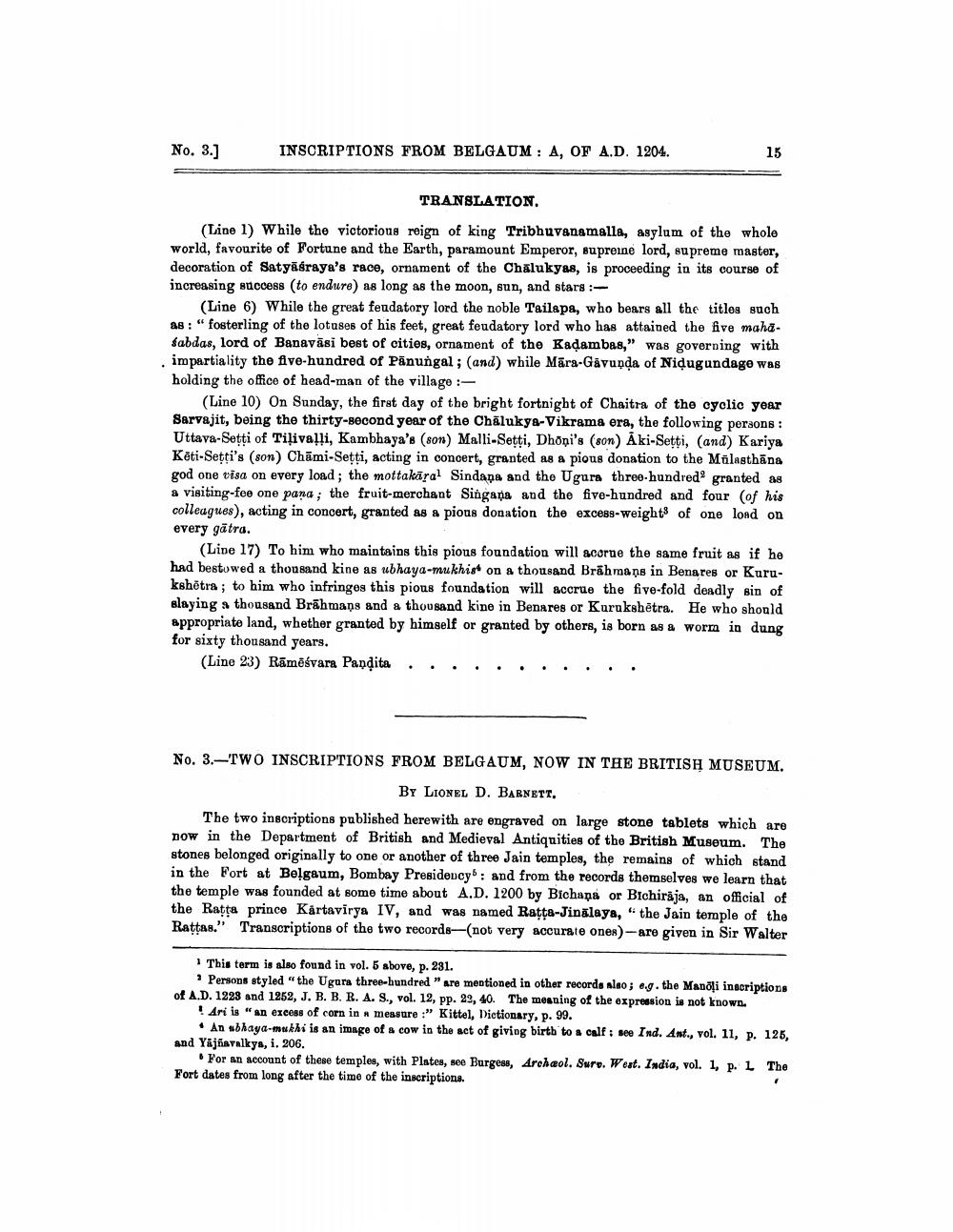________________
No. 3.]
INSCRIPTIONS FROM BELGAUM: A, OF A.D. 1204.
TRANSLATION. (Line 1) While the victorious reign of king Tribhuvanamalla, asylum of the whole world, favourite of Fortune and the Earth, paramount Emperor, suprenne lord, supreme master, decoration of Satyasraya's race, ornament of the Chalukyas, is proceeding in its course of increasing success (to endure) as long as the moon, sun, and stars :
(Line 6) While the great fendatory lord the noble Tailapa, who bears all the titlog such as : " fosterling of the lotuses of his feet, great feudatory lord who has attained the five mahaSabdas, lord of Banavasi best of cities, ornament of the Kadambas," was governing with impartiality the five-hundred of Pānungal; (and) while Māra-Gávunda of Nidugundage was holding the office of head-man of the village :
(Line 10) On Sunday, the first day of the bright fortnight of Chaitra of the cyclic year Sarvajit, being the thirty-second year of the Chalukya-Vikrama era, the following peraons : Uttava-Setti of Tiļivalli, Kambhaya's (son) Malli-Setti, Dhoni's (son) Aki-Setti, (and) Kariya Kēti-Setti's (son) Chāmi-Setti, acting in concert, granted as a pious donation to the Mülasthāns god one visa on every load; the mottakāral Sindana and the Ugara three hundred granted as a visiting-foe one pana; the fruit-merchant Singana and the five-hundred and four of his colleagues), acting in concert, granted as a pions donation the excess-weights of one load on every gatra.
(Lide 17) To him who maintains this pions foundation will scorne the same fruit as if he had bestowed a thousand kine as ubhaya-mukhist on a thousand Brāhmans in Benares or Kurukshētra ; to him who infringes this pious foundation will accrue the five-fold deadly sin of slaying a thousand Brāhmans and a thousand kine in Benares or Kurukshētra. He who should appropriate land, whether granted by himself or granted by others, is born as a worm in dung for sixty thousand years.
(Line 23) Rāmēśvara Pandita . . . . . . . . .
No. 3.-TWO INSCRIPTIONS FROM BELGAUM, NOW IN THE BRITISH MUSEUM.
BY LIONEL D. BARNETT. The two inscriptions published herewith are engraved on large stone tablets which are now in the Department of British and Medieval Antiquities of the British Museum. The stones belonged originally to one or another of three Jain temples, the remains of which stand in the Fort at Belgaum, Bombay Presidency: and from the records themselves we learn that the temple was founded at some time about A.D. 1200 by Bichana or Bichirăja, an official of the Ratta prince Kartavirya IV, and was named Ratta-Jinalaya," the Jain temple of the Rattas." Transcriptions of the two records—(not very accurate ones)-are given in Sir Walter
1 This term is also found in vol. 5 above, p. 231.
? Persons styled "the Ugura three-hundred "Are mentioned in other records alaos eg. the Manosi inscriptions of A.D. 1228 and 1252, J. B. B. R. A. S., vol. 12, pp. 22, 40. The meaning of the expression is not known.
! Ari is an excess of corn in a measure :" Kittel, Dictionary, p. 99.
• An sbhaya-mukhi is an image of a cow in the act of giving birth to a calf : see Ind. Ant., vol. 11, p. 125, and Yajfiavalkya, i. 206.
For an account of these temples, with Plates, see Burgess, Archeol. Sury. West. India, vol. 1, P. L The Fort dates from long after the time of the inscriptions




